In 2025, the hair finishing stick market is valued at USD 1.3 billion and is expected to reach USD 2.3 billion by 2035, growing at a CAGR of 5.9%. The absolute dollar opportunity over this period is USD 1.0 billion, representing the additional market potential from 2025 to 2035. This growth reflects increasing consumer adoption and demand across personal care and grooming segments. Companies can leverage this opportunity by expanding product availability, optimizing distribution channels, and targeting high-demand regions.
The incremental growth provides a clear financial incentive for strategic planning and investment in production and marketing initiatives throughout the decade. From a business perspective, the USD 1.0 billion absolute dollar opportunity highlights significant revenue potential for market participants. With the market gradually rising from USD 1.3 billion in 2025 to USD 2.3 billion in 2035 at a CAGR of 5.9%, firms can plan phased investments and scale operations to align with demand. This predictable growth allows for efficient resource allocation, production planning, and marketing strategy development. By targeting key consumer segments and enhancing product accessibility, stakeholders can maximize revenue capture, improve market share, and strengthen their competitive positioning over the ten-year growth trajectory.
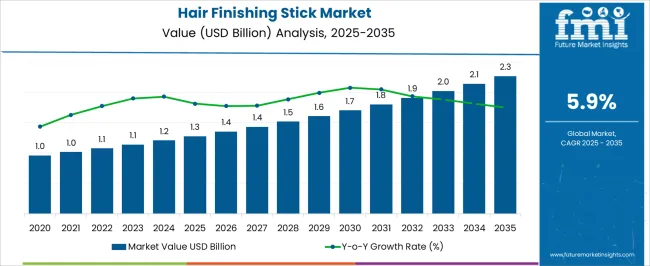
| Metric | Value |
|---|---|
| Hair Finishing Stick Market Estimated Value in (2025 E) | USD 1.3 billion |
| Hair Finishing Stick Market Forecast Value in (2035 F) | USD 2.3 billion |
| Forecast CAGR (2025 to 2035) | 5.9% |
A breakpoint analysis for the hair finishing stick market highlights critical thresholds where growth accelerates or strategic adjustments are needed. With the market valued at USD 1.3 billion in 2025 and projected to reach USD 2.3 billion by 2035 at a CAGR of 5.9%, early breakpoints occur around USD 1.5–1.6 billion. These levels represent the initial phase of increased adoption and expanding consumer demand, signaling opportunities for companies to enhance distribution, increase product availability, and invest in marketing campaigns.
Recognizing these breakpoints helps stakeholders allocate resources efficiently and capture revenue during periods of accelerated growth. Later-stage breakpoints occur between USD 2.0–2.1 billion as the market approaches maturity and competition intensifies. Surpassing these thresholds may require firms to optimize operations, refine pricing strategies, and strengthen customer engagement to maintain growth momentum. Monitoring these breakpoints ensures businesses can anticipate shifts in demand and adjust production, marketing, and distribution strategies accordingly.
The Hair Finishing Stick market is experiencing steady expansion, driven by evolving consumer grooming habits and rising demand for convenient hair styling solutions. The market outlook is shaped by increasing awareness of personal appearance and a growing preference for easy-to-use products that provide natural and long-lasting finishes.
Innovation in product formulations and packaging has enhanced user experience, supporting widespread adoption. Additionally, expanding urban populations and increased disposable incomes in developing regions are contributing to market growth.
The focus on multifunctional products that combine styling with hair nourishment is also creating new avenues for growth As grooming routines continue to evolve, the demand for products that offer quick application and reliable performance is expected to further strengthen the market position of hair finishing sticks globally.
The hair finishing stick market is segmented by type, finishing product, hair type, pricing, end use, distribution channel, and geographic regions. By type, hair finishing stick market is divided into Cylindrical sticks, Rectangular sticks, Brush-on sticks, and Others (Dual sided Sticks, etc.). In terms of finishing product, hair finishing stick market is classified into Gel based, Wax Based, Cream Based, and Others (Oil infused, etc.).
Based on hair type, hair finishing stick market is segmented into Normal hair, Curl hair, Dry hair, Straight hair, and Others (Wavy Hair, etc.). By pricing, hair finishing stick market is segmented into Low (USD 1 - USD 50), Medium (USD 50-100), and High (>USD 100). By end use, hair finishing stick market is segmented into Individual and Commercial. By distribution channel, hair finishing stick market is segmented into Online and Offline. Regionally, the hair finishing stick industry is classified into North America, Latin America, Western Europe, Eastern Europe, Balkan & Baltic Countries, Russia & Belarus, Central Asia, East Asia, South Asia & Pacific, and the Middle East & Africa.
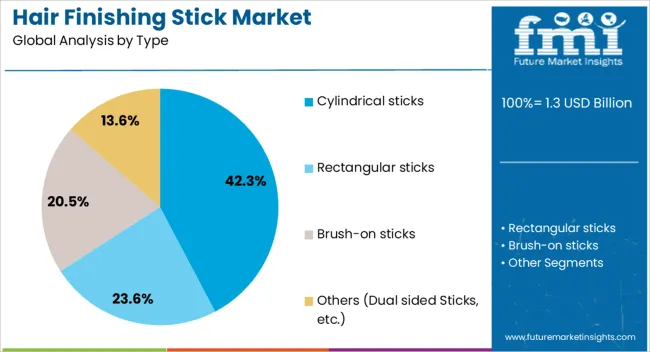
The Cylindrical sticks type is projected to hold 42.3% of the Hair Finishing Stick market revenue share in 2025, making it the leading segment in terms of product type. This preference is being driven by the ergonomic design that allows easy handling and precise application, which enhances user convenience.
The form factor also supports compact packaging and portability, meeting the needs of consumers with active lifestyles. Growth in this segment has been supported by increased demand in both professional and personal grooming contexts where quick touch-ups and defined styling are valued.
Additionally, cylindrical sticks facilitate the incorporation of diverse formulations, enabling brands to cater to different hair styling requirements while maintaining product stability and ease of use.

The Gel based finishing product segment is expected to capture 38.7% of the market revenue share in 2025, emerging as the preferred finishing product type. This segment’s growth has been influenced by consumer demand for styling products that offer strong hold combined with a natural look and feel.
Gel formulations provide flexibility in application, allowing for varying levels of shine and hold without stiffness. The ability to incorporate nourishing ingredients in gel bases further appeals to consumers seeking multifunctional hair care and styling solutions.
The versatility of gel based products across different hair types and styles has reinforced its position, while advancements in non-sticky, fast-drying formulas have enhanced user satisfaction and broadened market appeal.
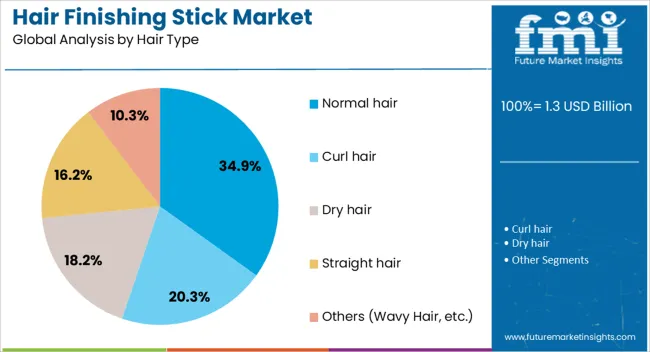
The Normal hair type segment is anticipated to hold 34.9% of the Hair Finishing Stick market revenue share in 2025, representing the largest end-user group. This dominance has been driven by the widespread prevalence of normal hair types globally, making it the primary target for manufacturers and marketers.
Products designed for normal hair typically balance styling hold with hair health, which aligns with consumer preferences for natural appearance and ease of styling. The focus on maintaining hair texture while providing effective finishing has supported demand in this segment.
Moreover, normal hair consumers tend to seek reliable products that work across different occasions and hair conditions, further reinforcing the segment’s significant market share. The segment is expected to maintain its leadership due to its broad applicability and sustained consumer interest.
The hair finishing stick market is growing due to rising consumer interest in personal grooming, professional hairstyling, and portable, easy-to-use styling products. North America and Europe lead in premium, multifunctional sticks with heat protection and anti-frizz polymers, while Asia-Pacific shows rapid growth through affordable, mass-market options. Manufacturers differentiate through ingredient formulation, portability, and application ease. Market expansion is driven by DIY hairstyling, salon adoption, and influencer-led beauty trends. Regional differences in hair types, styling behavior, and pricing affect adoption and supplier competitiveness globally.
Hair finishing sticks vary in wax content, polymers, and protective oils. Europe and North America favor multifunctional sticks with high-quality polymers, natural oils, and anti-frizz ingredients for professional and home use, offering strong hold and smooth texture. Asia-Pacific consumers often adopt simpler, cost-effective sticks focusing on shine and basic styling. Differences in formulation affect styling durability, hair protection, and user satisfaction. Leading manufacturers invest in research for advanced protective formulas, while regional suppliers emphasize affordability. These contrasts shape adoption patterns, brand positioning, and competitiveness, with premium formulations driving growth in developed markets and basic usability capturing emerging market volumes.
Compact design, portability, and ergonomic construction influence consumer acceptance. North America and Europe prioritize sleek, travel-friendly sticks suitable for quick touch-ups and professional use. Asia-Pacific markets favor larger or multipurpose sticks for cost-conscious buyers. Differences in packaging and portability affect ease of use, repeat purchases, and brand loyalty. Manufacturers offering lightweight, safe, and aesthetically appealing sticks capture premium consumers, while regional producers focus on functional, budget-friendly formats. Design contrasts directly influence regional adoption, product differentiation, and market competitiveness, shaping marketing and distribution strategies in professional and mass-market segments.
Hair finishing sticks are sold through e-commerce, specialty beauty stores, professional salons, and mass-market retail outlets. Europe and North America emphasize online platforms, salon partnerships, and high-end retail, while Asia-Pacific relies on supermarkets, local retailers, and emerging online marketplaces. Differences in distribution affect market access, pricing, and brand visibility. Global suppliers leverage multi-channel strategies with after-sales engagement to strengthen customer loyalty, whereas regional producers compete through cost-effective local distribution. These contrasts determine adoption speed, brand recognition, and penetration in both mature and emerging markets. Effective distribution strategies remain critical for reaching both professional and home-use segments.
Regional hair types, styling behaviors, and cultural preferences influence product demand. North America and Europe prioritize frizz control, shine enhancement, and hair protection for diverse hair textures. Asia-Pacific focuses on ease of use, affordability, and quick styling for straight, wavy, or curly hair common in local populations.
Differences in styling habits impact product development, marketing, and adoption rates. Manufacturers offering products tailored to regional hair needs gain competitive advantages in premium markets, while regional producers meet basic styling requirements. Understanding these contrasts allows companies to optimize product features, marketing campaigns, and regional expansion strategies.

| Country | CAGR |
|---|---|
| China | 8.0% |
| India | 7.4% |
| Germany | 6.8% |
| France | 6.2% |
| UK | 5.6% |
| USA | 5.0% |
| Brazil | 4.4% |
The global hair finishing stick market was projected to grow at a 5.9% CAGR through 2035, driven by demand in personal care, hairstyling, and grooming applications. Among BRICS nations, China recorded 8.0% growth as large-scale production facilities were commissioned and compliance with product quality and safety standards was enforced, while India at 7.4% growth saw expansion of manufacturing units to meet rising regional consumer demand. In the OECD region, Germany at 6.8% maintained substantial output under strict cosmetic and industrial regulations, while the United Kingdom at 5.6% relied on moderate-scale operations for personal care and hairstyling products. The USA, expanding at 5.0%, remained a mature market with steady demand across home and professional grooming segments, supported by adherence to federal and state-level safety and quality standards. This report includes insights on 40+ countries; the top five markets are shown here for reference.
Hair finishing stick market in China is growing at a CAGR of 8.0%. Between 2020 and 2024, growth was driven by rising beauty consciousness, increasing disposable income, and urbanization. Consumers preferred compact, easy-to-use, and travel-friendly finishing sticks for styling, frizz control, and smoothness. Manufacturers focused on lightweight, high-quality, and skin-safe formulations, with natural and non-greasy textures. E-commerce and retail channels expanded product availability across tier-1 and tier-2 cities. In the forecast period 2025 to 2035, growth is expected to accelerate with adoption of multifunctional, eco-friendly, and smart beauty finishing sticks. Social media influence, expanding professional salon partnerships, and rising male grooming trends will further support market growth. China remains a leading market due to high urban population, growing beauty industry, and consumer demand for convenient styling products.
Hair finishing stick market in India is growing at a CAGR of 7.4%. Historical period 2020 to 2024 saw growth supported by increasing grooming awareness, rise of e-commerce platforms, and expanding salon and professional styling industry. Consumers preferred compact, travel-friendly, and easy-to-use finishing sticks for hair styling and frizz control. Manufacturers focused on safe, lightweight, and multifunctional formulations suitable for local hair types. In the forecast period 2025 to 2035, growth is expected to continue with adoption of eco-friendly, multifunctional, and professional-grade finishing sticks. Rising male grooming trends, social media styling influence, and expansion of organized beauty retail will further boost adoption. India is projected to maintain strong growth due to growing urbanization, disposable income, and rising demand for convenient hair styling solutions.
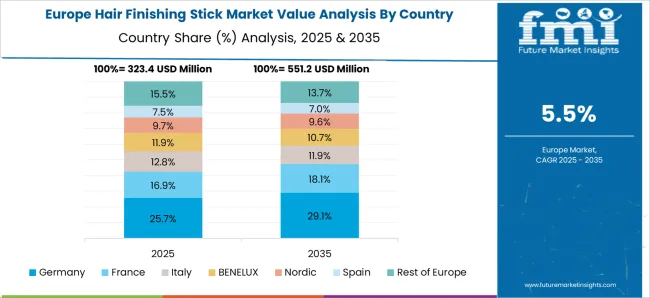
Hair finishing stick market in Germany is growing at a CAGR of 6.8%. Between 2020 and 2024, growth was supported by rising focus on personal grooming, professional hairstyling, and preference for high-quality, non-greasy, and safe formulations. Manufacturers focused on ergonomic design, premium ingredients, and multifunctionality to meet consumer demand. In the forecast period 2025 to 2035, market growth is expected to continue steadily with adoption of eco-friendly, sustainable, and smart hair finishing sticks. Increasing awareness of sustainable beauty products, advanced hairstyling trends, and premium salon adoption will further support the market. Germany remains a key European market due to high disposable income, focus on product quality, and sustainability-driven consumer behavior.
Hair finishing stick market in the United Kingdom is growing at a CAGR of 5.6%. During 2020 to 2024, adoption was driven by rising demand for home and professional hairstyling solutions, convenience of compact products, and growth of retail and online distribution channels. Manufacturers focused on safe, lightweight, and multifunctional formulations with natural and non-greasy textures. In the forecast period 2025 to 2035, market growth is expected to continue moderately with adoption of eco-friendly, multifunctional, and premium finishing sticks. Expansion of professional salons, social media styling influence, and rising male grooming trends will further support adoption. The United Kingdom market demonstrates steady growth with emphasis on convenience, product quality, and environmental sustainability.
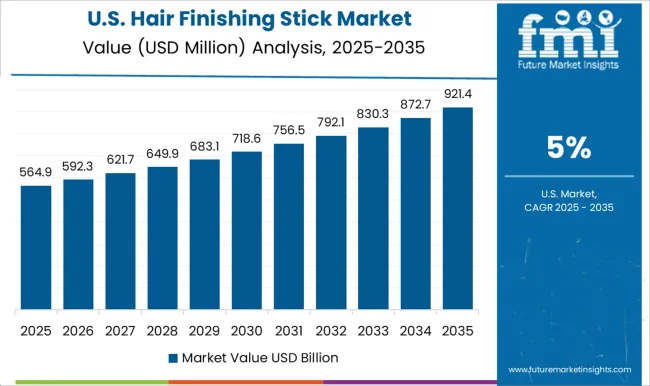
Hair finishing stick market in the United States is growing at a CAGR of 5.0%. Historical period 2020 to 2024 saw growth fueled by rising personal grooming awareness, professional hairstyling adoption, and online retail penetration. Consumers preferred compact, travel-friendly, and multifunctional sticks for frizz control, shine, and styling convenience. Manufacturers focused on high-quality, skin-safe, and lightweight formulations. In the forecast period 2025 to 2035, growth is expected to continue steadily with adoption of eco-friendly, multifunctional, and premium finishing sticks. Social media influence, expanding male grooming products, and growth in salon partnerships will further support market expansion. The United States market demonstrates consistent growth with emphasis on convenience, product performance, and sustainability trends.
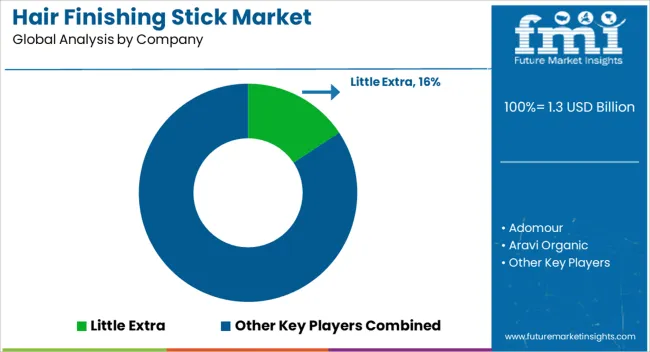
The hair finishing stick market is supplied by Little Extra, Adomour, Aravi Organic, Happy Heads, Incolor, JBabe USA, KAPCO INTERNATIONAL LIMITED, Ktein Biotech Private Limited, Nourish Mantra, ORGATRE, Samisha Organic, Sanfe, Sleek N Easy, and Sotrue. Competition is shaped by ingredient formulation, hold strength, finish type, and ease of application. Little Extra and Aravi Organic brochures emphasize natural and organic ingredients with non-greasy finishes. Adomour and Happy Heads highlight anti-frizz properties and lightweight formulas suitable for all hair types. JBabe USA and Ktein Biotech datasheets specify vitamin-enriched formulas, skin-friendly components, and dermatologically tested products.
Observed patterns show increasing demand for portable, eco-friendly sticks that combine styling and nourishing benefits. Supplier strategies focus on product differentiation, distribution channels, and consumer engagement. Organic and natural formulations are emphasized by Aravi Organic, Samisha Organic, and Nourish Mantra for premium and health-conscious segments. Sanfe, Sleek N Easy, and Sotrue prioritize affordability and convenience for mass-market adoption. Little Extra and Incolor invest in travel-friendly packaging, easy application, and multifunctional benefits.
| Item | Value |
|---|---|
| Quantitative Units | USD 1.3 Billion |
| Type | Cylindrical sticks, Rectangular sticks, Brush-on sticks, and Others (Dual sided Sticks, etc.) |
| Finishing Product | Gel based, Wax Based, Cream Based, and Others (Oil infused, etc.) |
| Hair Type | Normal hair, Curl hair, Dry hair, Straight hair, and Others (Wavy Hair, etc.) |
| Pricing | Low (USD 1 - USD 50), Medium (USD 50-100), and High (>USD 100) |
| End Use | Individual and Commercial |
| Distribution Channel | Online and Offline |
| Regions Covered | North America, Europe, Asia-Pacific, Latin America, Middle East & Africa |
| Country Covered | United States, Canada, Germany, France, United Kingdom, China, Japan, India, Brazil, South Africa |
| Key Companies Profiled | Little Extra, Adomour, Aravi Organic, Happy Heads, Incolor, JBabe USA, KAPCO INTERNATIONAL LIMITED, Ktein Biotech Private Limited, Nourish Mantra, ORGATRE, Samisha Organic, Sanfe, Sleek N Easy, and Sotrue |
| Additional Attributes | Dollar sales vary by product type, including wax sticks, pomade sticks, and serum-infused sticks; by application, such as hair styling, frizz control, and flyaway management; by end-use, spanning individual consumers, salons, and professional stylists; by region, led by North America, Europe, and Asia-Pacific. Growth is driven by rising grooming trends, demand for convenient styling tools, and increasing focus on hair aesthetics. |
The global hair finishing stick market is estimated to be valued at USD 1.3 billion in 2025.
The market size for the hair finishing stick market is projected to reach USD 2.3 billion by 2035.
The hair finishing stick market is expected to grow at a 5.9% CAGR between 2025 and 2035.
The key product types in hair finishing stick market are cylindrical sticks, rectangular sticks, brush-on sticks and others (dual sided sticks, etc.).
In terms of finishing product, gel based segment to command 38.7% share in the hair finishing stick market in 2025.






Full Research Suite comprises of:
Market outlook & trends analysis
Interviews & case studies
Strategic recommendations
Vendor profiles & capabilities analysis
5-year forecasts
8 regions and 60+ country-level data splits
Market segment data splits
12 months of continuous data updates
DELIVERED AS:
PDF EXCEL ONLINE
Hair Mineral Analyzer Market Size and Share Forecast Outlook 2025 to 2035
Hair Regrowth Treatments Market Size and Share Forecast Outlook 2025 to 2035
Hair Growth Promoters / Anti-Hair Loss Agents Market Size and Share Forecast Outlook 2025 to 2035
Hair Extension Market Size and Share Forecast Outlook 2025 to 2035
Hair Bond Multiplier Market Size and Share Forecast Outlook 2025 to 2035
Hair Loss Prevention Products Market Size and Share Forecast Outlook 2025 to 2035
Hair Thinning Solutions Market Analysis - Size and Share Forecast Outlook 2025 to 2035
Hair Growth Serums Market Analysis - Size and Share Forecast Outlook 2025 to 2035
Hair Serum Market Size and Share Forecast Outlook 2025 to 2035
Hair Mask Market Size and Share Forecast Outlook 2025 to 2035
Hair Straightener Market Size and Share Forecast Outlook 2025 to 2035
Hair Removal Wax Pen Market Size and Share Forecast Outlook 2025 to 2035
Hair Perfume Market Size and Share Forecast Outlook 2025 to 2035
Hair Dryer Market Analysis - Size, Share, and Forecast Outlook 2025 to 2035
Hair Serums Ingredient Market Size and Share Forecast Outlook 2025 to 2035
Hair Lightening Products Market Size and Share Forecast Outlook 2025 to 2035
Haircare Supplement Market - Size, Share, and Forecast Outlook 2025 to 2035
Hair Care Market Size and Share Forecast Outlook 2025 to 2035
Hair Wig and Extension Market Analysis – Size, Share & Forecast 2025 to 2035
Hair Brush Market Analysis by Growth, Trends and Forecast from 2025 to 2035

Thank you!
You will receive an email from our Business Development Manager. Please be sure to check your SPAM/JUNK folder too.
Chat With
MaRIA